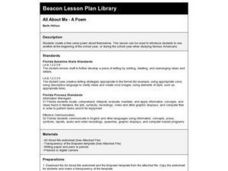Curated OER
My Name Is Me!
Students write about themselves. In this personal writing lesson, students write their name vertically down a sheet of paper and think of a self descriptive word that matches each letter of their name. Students write a descriptive...
Curated OER
Which Shoes Are Mine?
Fourth graders write down detailed descriptions of the shoes they are wearing that day. They participate in a relay descriping their shoes as they go.
Curated OER
Halloween Tales
Students work in groups to brainstorm and generate a list of Halloween characters, descriptive terms, and action words. Individuals choose a pre-determined writing prompt to enter into a Word document and complete the story using the...
Curated OER
All About Me - A Poem
Second graders brainstorm unique qualities they possess in a All About Me worksheet. They write free verse poems about things that most people don't know about them. They brainstorm descriptive words to enhance their poems and rewrite them.
Curated OER
Fall Similes and Metaphors
Young scholars interpret what a similies and metaphors are. They give examples of similies and metaphors. Pupils write different similies and metaphors using fall or autumn descriptive words. Students base their comparisons on facts,...
Curated OER
Animals of the Arctic
Sixth graders research an Arctic animal. They survey the questions in the Animal Report in order to conduct their research. They investigate their chosen animal by using the Internet, library books and reference books.
Curated OER
Lift Off with Rockets!
Students obtain information concerning rockets and the use of them in space, create their own rocket on the computer with the graphic choices on the website www.goobo.com, and write descriptive words or phrases to describe their rockets.
Curated OER
And Then What Happened?
Students analyze paintings by using verbs, adjectives, and nouns. In this visual arts lesson, students view a painting of a storm and a calm sky. Students use various verbs and adjectives to discuss the characteristics of each painting....
Curated OER
Writing Process- Expository Writing
Expository writing is the focus of the language arts lesson presented here. In it, young writers review what expository writing is through a class discussion and teacher demonstration. Then, learners write expository text that describes...
Curated OER
Explorations with Shapes
Students describe, identify and compare two-dimensional figures. They also name and demonstrate the relative position of objects using directional words. They sort and compare two-dimensional figures and three-dimensional objects...
Curated OER
Economics
Young scholars discover the resources that are available for consumer protection. In a database, they are responsible for entering two new vocabulary words each semester along with a sentence using the word. In groups, they create a...
Curated OER
Data Analysis and Probability: Graphing Candy with Excel
Collect and graph data using Microsoft Excel with your math class. They will make predictions about the number of each colored candy in a bag of M&M's, then sort, classify, count, and record the actual data before using Excel to...
Reed Novel Studies
Rascal: Novel Study
Some say a dog is a man's best friend. However, in Rascal, it is not a dog that captures a boy's heart—but a raccoon. Scholars read about the boy and Rascal's adventures while they complete activities about the story. Activities include...
Is it Even or Odd?
Brain Boosters: Daily Word Problem
Your youngsters will be able to determine whether the solution to the problem is even or odd by counting the number of cubes shown.
Curated OER
Conejito
Third graders read the story "Conejito" and write a descriptive story about the rainforest in Panama. They answer story comprehension questions, complete worksheet questions about a map of Panama, and rewrite a paragraph changing the...
Charleston School District
Sketching a Piecewise Function
How do you combine linear and nonlinear functions? You piece them together! The lesson begins by analyzing given linear piecewise functions and then introduces nonlinear parts. Then the process is reversed to create graphs from given...

















